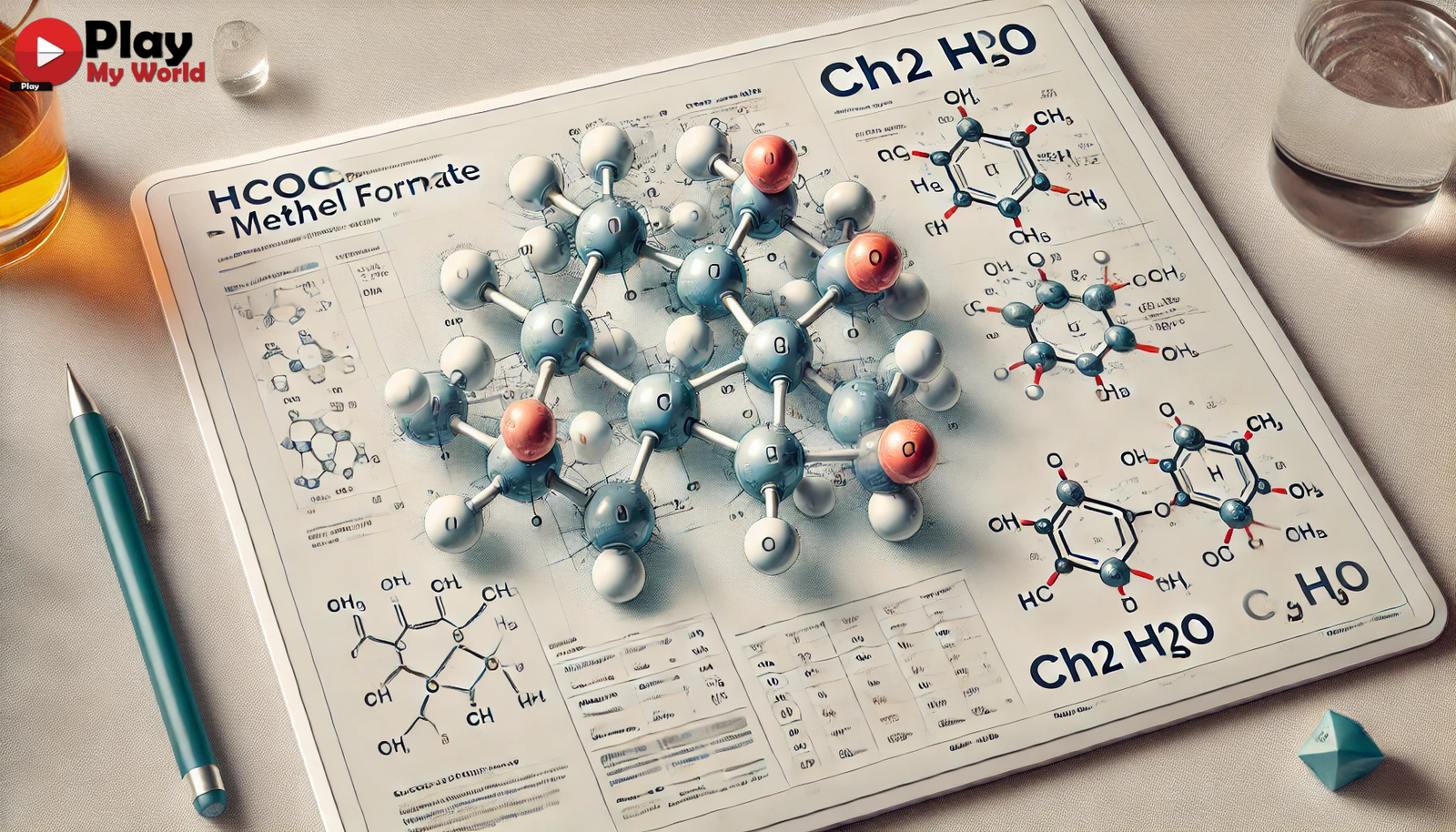Introduction
The chemical formula HCOOCH CH2 H2O suggests a reaction involving an ester, a methylene (-CH₂) group, and water (H₂O). Such reactions are fundamental in organic chemistry, industrial applications, and biological systems. Understanding how these components interact can provide insight into hydrolysis reactions, synthesis methods, and environmental processes.
This article explores the significance of HCOOCH (likely a formate ester), the role of CH₂ in chemical reactions, the function of H₂O in hydrolysis and transformations, practical applications in industries and biological systems, and a step-by-step guide to performing relevant reactions in a laboratory.
Understanding the Chemical Components
HCOOCH: What Does It Represent?
The notation HCOOCH appears incomplete but strongly resembles methyl formate (HCOOCH₃), an ester of formic acid (HCOOH) and methanol (CH₃OH).
Properties of Methyl Formate:
- Formula: HCOOCH₃
- Molar Mass: 60.05 g/mol
- Boiling Point: 31.5°C
- Solubility: Partially soluble in water, hydrolyzes easily
- Uses: Solvent, pesticide production, precursor for formic acid
Also Read: Software Updates Durostech: A Complete Guide to Enhancing Performance and Security
The Role of CH₂ (Methylene Group)
The methylene (-CH₂-) group is a fundamental part of organic molecules and plays a crucial role in:
- Polymer chemistry (used in plastics, fibers, and resins)
- Organic synthesis (intermediate in forming larger molecules)
- Hydrocarbon chains (backbone of fuels and biological molecules)
H₂O (Water) as a Reactant
Water is essential in hydrolysis reactions, where it breaks down molecules. In organic chemistry, H₂O acts as a catalyst, a reactant, or a solvent in various reactions.
Hydrolysis of HCOOCH CH2 H2O: The Key Reaction
The presence of HCOOCH and H₂O suggests a hydrolysis reaction, breaking the ester into a carboxylic acid and an alcohol.
General Ester Hydrolysis Reaction
RCOOR′+H2O→RCOOH+R′OHRCOOR’ + H₂O → RCOOH + R’OHRCOOR′+H2O→RCOOH+R′OH
For HCOOCH₃ (methyl formate):HCOOCH3+H2O→HCOOH+CH3OHHCOOCH₃ + H₂O → HCOOH + CH₃OHHCOOCH3+H2O→HCOOH+CH3OH
This reaction produces formic acid (HCOOH) and methanol (CH₃OH) and can be catalyzed by acids (H⁺) or bases (OH⁻).
Acid-Catalyzed vs. Base-Catalyzed Hydrolysis
| Factor | Acid-Catalyzed Hydrolysis | Base-Catalyzed Hydrolysis (Saponification) |
|---|---|---|
| Catalyst | HCl, H₂SO₄ (Strong Acids) | NaOH, KOH (Strong Bases) |
| Products | Carboxylic Acid + Alcohol | Carboxylate Salt + Alcohol |
| Reversibility | Reversible | Irreversible |
| Industrial Uses | Drug synthesis, food chemistry | Soap-making, biodiesel production |
The Influence of CH₂ in Reactions
If CH₂ is part of a larger molecule, hydrolysis can lead to:
- Breakdown of polymer structures (if CH₂ is in a polymer chain)
- Rearrangement of organic frameworks (in biological or industrial processes)
Industrial and Biological Applications
Industrial Uses of HCOOCH CH2 H2O Reactions
- Production of Formic Acid: Used in leather processing, preservatives, and rubber manufacturing.
- Methanol Synthesis: Used in fuels, chemicals, and antifreeze.
- Polymer Chemistry: CH₂-containing esters contribute to plastics, coatings, and resins.
- Pharmaceutical Industry: Used in drug formulations and synthesis.
Biological and Environmental Significance
- Enzymatic Hydrolysis: Enzymes like esterases break down esters in metabolism.
- Biodegradable Materials: Many esters and CH₂-containing compounds degrade naturally through hydrolysis.
- Water Treatment: Organic pollutants often undergo ester hydrolysis in wastewater treatment plants.
Step-by-Step Guide to Hydrolyzing HCOOCH CH2 H2O in the Lab
If you want to perform ester hydrolysis in a lab setting, follow this step-by-step method.
Materials Required
- Methyl formate (HCOOCH₃)
- Water (H₂O)
- Acid catalyst (HCl) or base (NaOH)
- Glassware (flask, beaker, pipette)
- Heat source (for controlled reaction conditions)
Procedure for Acid-Catalyzed Hydrolysis
- Prepare the solution: Mix methyl formate with an equal volume of water.
- Add catalyst: Add a few drops of HCl (acidic medium).
- Heat gently: Increase the temperature to 50–70°C to speed up the reaction.
- Observe the reaction: Methyl formate hydrolyzes, releasing formic acid and methanol.
- Confirm completion: Use pH indicators or spectroscopy to detect formic acid formation.
Procedure for Base-Catalyzed Hydrolysis (Saponification)
- Replace HCl with NaOH for an irreversible reaction.
- Heat to ~80°C, causing ester cleavage.
- Observe formation of sodium formate (HCOO⁻Na⁺) instead of formic acid.
- Methanol is released, and the reaction is complete.
This base-catalyzed method is widely used in soap-making and biodiesel production.
Also Read: About Vollnou8.7z Fix About Wtonecap3.0.34 Software Now: A Comprehensive Guide
Factors Affecting the Reaction of HCOOCH CH2 H2O
Temperature
- Higher temperatures accelerate hydrolysis.
- Excess heat can cause side reactions or decomposition.
pH Conditions
- Acidic hydrolysis (H⁺) maintains equilibrium.
- Basic hydrolysis (OH⁻) is irreversible and widely used in industries.
Water Concentration
- Excess water shifts equilibrium toward hydrolysis.
- Low water availability slows or inhibits reaction progress.
Conclusion
The reaction of HCOOCH CH2 H2O involves ester hydrolysis, a fundamental transformation in organic synthesis, industrial applications, and biological metabolism. Whether breaking down esters for formic acid and methanol production, polymer chemistry, or environmental biodegradation, understanding this reaction is essential.
Key Takeaways:
- HCOOCH likely represents methyl formate, an ester that hydrolyzes in water.
- CH₂ groups influence reaction mechanisms in polymers and biological systems.
- H₂O drives hydrolysis, breaking esters into carboxylic acids and alcohols.
- Industrial applications include formic acid production, fuel processing, and pharmaceuticals.
This knowledge is valuable for researchers, industrial chemists, and students studying organic reactions and hydrolysis mechanisms.
FAQs on HCOOCH CH₂ H₂O: Chemistry, Reactions, and Applications
What does HCOOCH CH₂ H₂O represent?
The formula HCOOCH CH₂ H₂O appears to refer to a reaction involving an ester (HCOOCH), a methylene (-CH₂) group, and water (H₂O). A likely interpretation is the hydrolysis of methyl formate (HCOOCH₃) in the presence of water, producing formic acid (HCOOH) and methanol (CH₃OH).
What is methyl formate (HCOOCH₃)?
Methyl formate is an ester of formic acid (HCOOH) and methanol (CH₃OH). It is used as a solvent, chemical intermediate, and precursor in industrial processes.
How does H₂O participate in the reaction?
Water acts as a reactant in hydrolysis reactions, breaking the ester bond in HCOOCH₃ to form a carboxylic acid (HCOOH) and an alcohol (CH₃OH). It can also serve as a solvent for chemical reactions.
What happens when HCOOCH₃ undergoes hydrolysis?
The reaction follows this general equation:HCOOCH3+H2O→HCOOH+CH3OHHCOOCH₃ + H₂O → HCOOH + CH₃OHHCOOCH3+H2O→HCOOH+CH3OH
This means methyl formate reacts with water to produce formic acid and methanol. The reaction can be catalyzed by acids (HCl, H₂SO₄) or bases (NaOH, KOH).
What is the role of the CH₂ group in this reaction?
The CH₂ group may indicate an additional reactive site in a polymer or organic molecule. If part of a larger molecular structure, it can influence polymer breakdown, rearrangements, or further chemical reactions.




